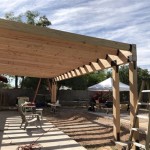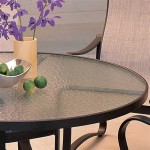Patio Floor Tiles Design: Enhancing Outdoor Living Spaces
The design of patio floor tiles significantly impacts the aesthetic appeal and functionality of outdoor living spaces. Careful consideration of tile materials, patterns, colors, and installation techniques is crucial in creating a patio that complements the surrounding environment and meets the specific needs of the homeowner. The selection process should prioritize durability, slip resistance, and ease of maintenance, in addition to the desired aesthetic qualities.
Patios serve as extensions of the home, providing spaces for relaxation, entertainment, and dining. Therefore, the flooring should reflect the homeowner's personal style while withstanding the elements. The market offers a diverse range of patio floor tile options, from natural stone to porcelain and concrete, each with its unique benefits and drawbacks. Understanding these characteristics is essential for making an informed decision.
Material Selection: A Foundation for Longevity
The choice of material is the most fundamental aspect of patio floor tile design. The material directly influences the tile's durability, appearance, and maintenance requirements. Several popular options exist, each offering distinct advantages and disadvantages.
Natural Stone: Natural stone tiles, such as slate, travertine, and flagstone, offer a timeless and elegant aesthetic. Their natural variations in color and texture create a unique and organic feel. However, natural stone can be porous and require sealing to prevent staining and water damage. The cost of natural stone can also be higher compared to other options, and installation may require specialized expertise.
Slate, known for its layered appearance and resistance to cracking, brings a rustic and sophisticated touch to patios. Its natural variations in color, from grays and blacks to greens and purples, complement various landscaping styles. However, slate can be susceptible to chipping if not properly sealed and maintained.
Travertine, with its warm earthy tones and pitted surface, evokes a Mediterranean ambiance. Its porous nature provides excellent slip resistance, making it a safe choice for pool decks and areas prone to moisture. However, travertine requires regular sealing to prevent staining and can be susceptible to damage from harsh chemicals.
Flagstone, a sedimentary rock characterized by its irregular shapes and sizes, offers a natural and rugged look. Its durability and slip resistance make it well-suited for high-traffic areas. Installation of flagstone can be more labor-intensive due to its irregular shapes, requiring careful planning and execution.
Porcelain: Porcelain tiles are a durable and versatile option for patio flooring. They are resistant to frost, staining, and fading, making them well-suited for outdoor environments. Porcelain tiles are also available in a wide range of colors, patterns, and textures, including options that mimic the look of natural stone or wood. This versatility allows for creating a variety of design styles, from contemporary to traditional.
The manufacturing process of porcelain tiles results in a dense and non-porous material, offering excellent water resistance and minimal maintenance. Porcelain tiles are also resistant to scratches and abrasion, making them ideal for areas with heavy foot traffic. However, porcelain tiles can be more expensive than some other options, and installation typically requires professional expertise.
Concrete: Concrete tiles offer a cost-effective and durable solution for patio flooring. They can be molded into various shapes and sizes and can be stained or stamped to create different textures and patterns. Concrete tiles are also relatively easy to install and maintain. However, concrete can be susceptible to cracking in extreme temperatures and may require sealing to prevent staining.
Stamped concrete allows for replicating the look of natural stone, brick, or other materials at a lower cost. The stamping process creates a textured surface that enhances slip resistance and adds visual interest. Staining concrete allows for customizing the color and appearance to match the surrounding landscape.
Composite: Composite tiles, typically made from recycled plastic and wood fibers, offer a sustainable and low-maintenance option for patio flooring. They are resistant to rot, insects, and fading, making them a durable choice for outdoor environments. Composite tiles are also easy to install and require minimal maintenance. However, composite tiles can be more expensive than concrete and may not offer the same aesthetic appeal as natural stone.
Pattern and Layout Considerations: Creating Visual Interest
The pattern and layout of patio floor tiles significantly influence the overall aesthetic of the space. Careful consideration of these elements can create visual interest, define specific areas within the patio, and enhance the sense of space.
Running Bond: The running bond pattern, also known as the brick pattern, is a classic and versatile choice for patio flooring. It involves laying rectangular tiles in an offset arrangement, with each row offset by half the length of the tile. This pattern creates a sense of movement and can make a small patio appear larger.
Herringbone: The herringbone pattern is a more complex and visually striking option. It involves laying rectangular tiles in a zigzag pattern, creating a dynamic and sophisticated look. The herringbone pattern is well-suited for formal patios and can add a touch of elegance to outdoor spaces.
Basket Weave: The basket weave pattern involves alternating pairs of rectangular tiles, creating a woven appearance. This pattern is a simple and elegant choice for patios and can be used to define specific areas within the space. The basket weave pattern is particularly well-suited for creating a focal point or accent area.
Modular: Modular patterns involve using tiles of different sizes and shapes to create a custom design. This approach allows for a high degree of flexibility and creativity, allowing homeowners to create a unique and personalized patio space. Modular patterns can be complex and require careful planning and execution.
Placement Considerations: Tile placement affects the overall visual flow. Aligning tile patterns with the architecture of the house or surrounding landscape can create a cohesive design. Strategically placing darker or lighter tiles can create shadows or highlights, adding depth and dimension to the patio.
Color and Texture: Shaping the Ambiance
The color and texture of patio floor tiles play a crucial role in shaping the ambiance of the outdoor space. Understanding the impact of these elements allows for creating a patio that reflects the desired mood and style.
Color Palette: Light-colored tiles can make a small patio appear larger and brighter, while darker colors can create a more intimate and cozy atmosphere. Neutral colors, such as beige, gray, and brown, are versatile and can complement a wide range of landscaping styles. Bold colors can add a pop of visual interest and create a focal point within the patio.
The color of the tiles should also complement the existing elements of the outdoor space, such as the house siding, landscaping, and outdoor furniture. A well-coordinated color scheme creates a harmonious and visually appealing environment.
Texture: Textured tiles can enhance slip resistance and add visual interest to the patio. Rough textures, such as those found in natural stone tiles, provide excellent grip and are well-suited for areas prone to moisture. Smooth textures, such as those found in polished porcelain tiles, can create a more formal and elegant look.
The texture of the tiles should also be appropriate for the intended use of the patio. For example, a patio used for dining may benefit from a smoother texture to prevent uneven surfaces for furniture placement. A patio used for lounging or sunbathing may benefit from a rougher texture to provide better grip and prevent slipping.
Climate Considerations: In warmer climates, lighter colored tiles help keep the patio cooler by reflecting sunlight. Darker tiles absorb more heat, which can be advantageous in cooler climates. The selected tile should also be able to withstand temperature fluctuations and UV exposure without fading or cracking.
In summary, designing patio floor tiles requires careful consideration of material selection, pattern and layout, and color and texture. By understanding the characteristics of different tile options and how they interact, homeowners can create outdoor living spaces that are both aesthetically pleasing and functionally sound.

Beautify Your Outdoor Space With These Tiles Nitco Blog

Outdoor Tile Plus Unaway Stn Floor Porcelain Natural Stone

Craft Outstanding Designs With Outdoor Floor Tiles From The Olvera Collection Granada Tile Cement Blog Ideas Tips And More

Floors For Outdoors Floor Trends Installation

60 Floor Tiles Design Ideas For Your Home

Outdoor Floor Tiles Best For Outside China Hanse Exterior Flooring Manufacturer

5 Best Outdoor Tile Ideas For Your Patio

Outdoor Tiles The Of

Mega Marble Grit Outdoor Floor Tiles By Favaro1 Design João Nunes

Biophilic Outdoor Floor Tiles Porcelain Stoneware With Stone Effect By Palli
Related Posts








